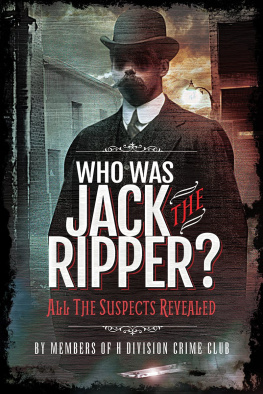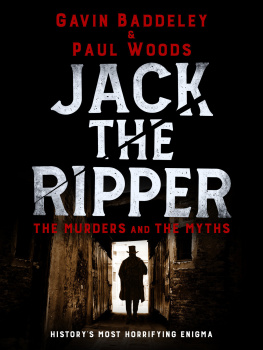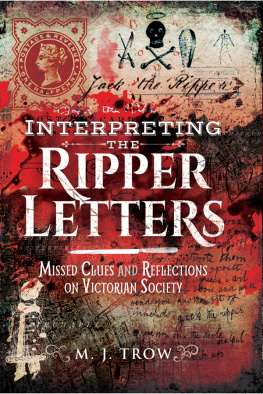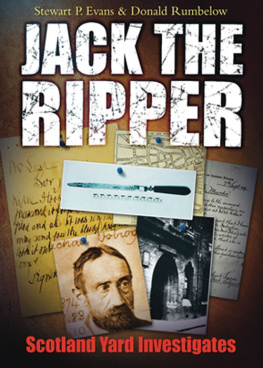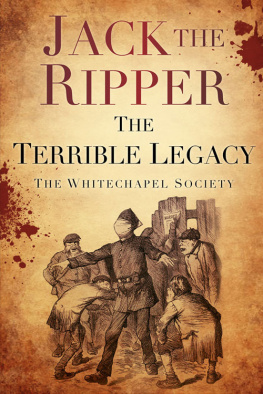Who was Jack the Ripper?

WHO WAS JACK THE RIPPER?
ALL THE SUSPECTS REVEALED
Dedicated to
the eternal memory of Martin Fido
WHO WAS JACK THE RIPPER?
ALL THE SUSPECTS REVEALED
B Y M EMBERS OF H: D IVISION CRIME CLUB
First published in Great Britain in 2019 by
PEN AND SWORD HISTORY
An imprint of
Pen & Sword Books Ltd
Yorkshire Philadelphia
Copyright Richard Charles Cobb acting on
behalf of H: Division Crime Club, 2019
ISBN 978 1 52674 872 0
eISBN 978 1 52674 873 7
Mobi ISBN 978 1 52674 874 4
The right of Richard Charles Cobb to be identified as Author of
this work has been asserted by him in accordance with the Copyright, Designs and Patents Act 1988.
A CIP catalogue record for this book is available from the British Library.
All rights reserved. No part of this book may be reproduced or transmitted in any form or by any means, electronic or mechanical including photocopying, recording or by any information storage and retrieval system, without permission from the Publisher in writing.
Pen & Sword Books Limited incorporates the imprints of Atlas, Archaeology, Aviation, Discovery, Family History, Fiction, History, Maritime, Military, Military Classics, Politics, Select, Transport, True Crime, Air World, Frontline Publishing, Leo Cooper, Remember When, Seaforth Publishing, The Praetorian Press, Wharncliffe Local History, Wharncliffe Transport, Wharncliffe True Crime and White Owl.
For a complete list of Pen & Sword titles please contact
PEN & SWORD BOOKS LIMITED
47 Church Street, Barnsley, South Yorkshire, S70 2AS, England
E-mail:
Website: www.pen-and-sword.co.uk
Or
PEN AND SWORD BOOKS
1950 Lawrence Rd, Havertown, PA 19083, USA
E-mail:
Website: www.penandswordbooks.com
What is H:Division?
The H:Division Crime Club originally started as a small group of enthusiasts studying the crimes of Jack the Ripper and the East End of London but over time soon grew to cover all aspects of true crime across the world. H:Division comprises some of the most respected researchers and authors in the field of Ripper studies and true crime. All experts under one roof.
As we originally formed searching for the identity of Jack the Ripper we decided to name ourselves after the original police unit that hunted the Ripper back in 1888 a homage to where we started and a reference to the ultimate crime mystery. Thus H:Division True Crime Club UK was born.
All our members share a wide range of crime interests, from the classic criminal cases of the Victorian era right the way through the twentieth century up to and including modern day crime investigations. We also have a deep interest in the historical aspects associated with each unique case and our members also include experts in the scientific and psychological aspects of crime investigation.
Our members include police officers, crime scene investigators, criminal psychologists, researchers, authors, true crime enthusiasts and armchair detectives.
The Crime Club is also a valuable research tool and helpline when investigating a new project, writing a book or studying. Our connections in the field have a wealth of knowledge and expertise to help any enthusiast.
We hold regular meetings and crime events across the UK. These meetings vary and include expert talks and tours and visits to locations relating to the history of UK crime.
For anyone interested in learning more about H:Division please visit our website www.crimeclubuk.com
Foreword
The Prime Suspects
By Professor David Canter
When asked to provide an introductory overview to a book of contributions proposing suspects for the Whitechapel murders I was surprised by what these accounts revealed. Perhaps the most salutary was the repeated revelations about the life and times of those living in the East End of London in the 1880s. These conditions are not just of historical interest. Not only do they provide the crucial backdrop for understanding the investigations into the horrific murders and the suspects who emerge, they also speak to us across the century with relevance today. This is a relevance both for understanding modern detective work as well as the consequences of desperate poverty and the degradation that often comes with it.
Again and again throughout these chapters we are reminded of the despairing conditions that drive women to dangerously sell sex on the street. This has echoes in the present day. Not long ago I studied the experiences of present-day street sex workers. Violence was accepted as part of their trade. Legal controls and police disdain only made this something they had to live with. In a subsequent study in the Netherlands, a country we mistakenly think of as liberal and facilitative towards prostitution, with the consequent assumption that these womens lives would not be so dangerous, I actually studied 120 murders of prostitutes, a great many of which had gone unsolved.
The murders in the East End of London in 1888 are therefore one more illustration of how predatory men will find vulnerable victims on whom to act out their predilections. Serial killers become skilled in knowing where to find women (usually) who are defenceless and in situations where they can attack and abuse them without being disturbed. This skill poses particular problems for any police investigation. Often the only thing the victims have in common is their vulnerability and location. They have no link to the killer. Consequently, there is no trail to follow of contacts and associations that will lead to the culprit.
In present day murder inquiries in the UK, in which there is no apparent link between the criminal and the victim, huge teams of police officers are put onto the task. One estimate is that it costs the taxpayer as much as a million pounds for these inquiries. When carried out systematically the process is to generate a comprehensive list of possible suspects, from police records, house-to-house enquiries and intelligence sources including informants. The process is then to trace each suspect, check his (typically) identity is correct and then eliminate him through availability, alibi or any other appropriate criteria. Those who survive this trawl then become key suspects who are examined very closely.
If there is any fibre or other forensic evidence, preferably fingerprints or DNA, this can be used to focus the trawl. Of course, if the culprits identifier is in police records, or comes into the searches of investigators that greatly speeds up the process. But none of this was available to the police in 1888.
Have you noticed that there have been no reports of serial killers in the UK in the last few years? This is the case, although the frequency of violent crime, notably knife and gun crime, has not decreased to a very great degree over that period. I put the lack of serial killers down, at least in part, to the improved effectiveness of the boys in blue. If a person kills a stranger, and gets away with it, that person is more dangerous. Whatever psychological processes gave rise to the killing they are not likely to have faded away. But now the murderer has determined the risks and how to avoid them. He may even believe his success is a sign from the fates that he ought to be doing what he is doing. In other words, incompetent policing facilitates serial killing.

